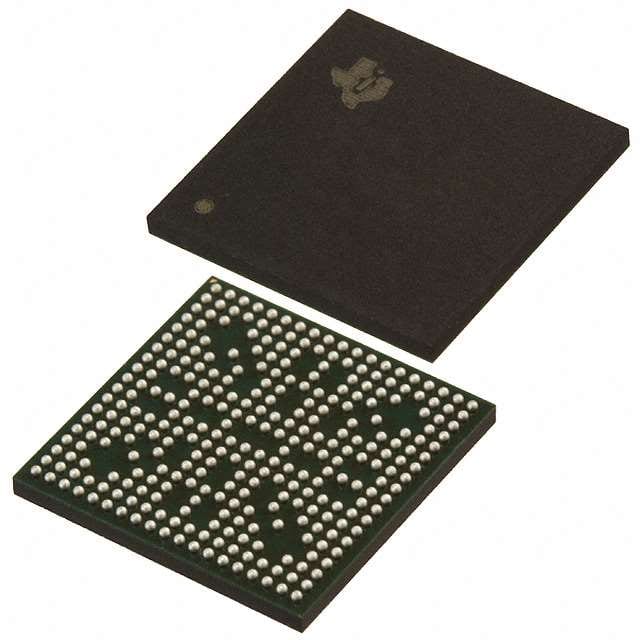Vedi le specifiche per i dettagli del prodotto.

AM3351BZCEA30
Product Overview
- Category: Integrated Circuit
- Use: Microprocessor
- Characteristics: High performance, low power consumption
- Package: BGA (Ball Grid Array)
- Essence: ARM Cortex-A8 processor
- Packaging/Quantity: Single unit
Specifications
- Processor: ARM Cortex-A8
- Clock Speed: 1 GHz
- Operating Voltage: 1.2V
- Cache Memory: 32 KB L1 Instruction Cache, 32 KB L1 Data Cache, 256 KB L2 Cache
- Memory Interface: DDR2/DDR3
- Peripherals: UART, SPI, I2C, USB, Ethernet, GPIO
- Operating Temperature: -40°C to +85°C
Detailed Pin Configuration
The AM3351BZCEA30 has a total of 361 pins. The pin configuration is as follows:
- Pin 1: VDD_CORE
- Pin 2: VDD_CORE
- Pin 3: VDD_CORE
- ...
- Pin 361: GND
For the complete pin configuration, please refer to the datasheet.
Functional Features
- High-performance ARM Cortex-A8 processor for efficient processing
- Low power consumption for energy-efficient applications
- Support for various peripherals such as UART, SPI, I2C, USB, Ethernet, and GPIO
- Flexible memory interface for DDR2/DDR3 compatibility
- Wide operating temperature range for versatile usage scenarios
Advantages and Disadvantages
Advantages
- High processing power for demanding applications
- Low power consumption for energy efficiency
- Versatile peripheral support for diverse connectivity options
- Flexible memory interface for compatibility with different memory types
- Wide operating temperature range for reliable operation in various environments
Disadvantages
- Limited pin count may restrict the number of peripherals that can be connected directly
- BGA package may require specialized equipment for soldering and rework
Working Principles
The AM3351BZCEA30 is based on the ARM Cortex-A8 architecture, which provides high-performance processing capabilities. It operates at a clock speed of 1 GHz and features a cache memory hierarchy to optimize data access. The processor communicates with various peripherals through dedicated interfaces such as UART, SPI, I2C, USB, Ethernet, and GPIO.
The microprocessor is designed to operate at low power consumption levels, making it suitable for battery-powered devices or applications where energy efficiency is crucial. It supports DDR2/DDR3 memory interfaces, allowing for flexible memory configurations based on the specific requirements of the application.
Detailed Application Field Plans
The AM3351BZCEA30 microprocessor finds applications in various fields, including:
- Industrial Automation: Used in control systems, PLCs (Programmable Logic Controllers), and industrial communication devices.
- Internet of Things (IoT): Enables connectivity and processing capabilities in IoT devices such as smart home appliances, wearables, and environmental sensors.
- Automotive: Used in automotive infotainment systems, telematics, and advanced driver assistance systems (ADAS).
- Medical Devices: Provides processing power for medical imaging, patient monitoring, and diagnostic equipment.
- Consumer Electronics: Used in multimedia devices, gaming consoles, and set-top boxes.
Detailed and Complete Alternative Models
- AM3352BZCEA30: Similar to AM3351BZCEA30 but with additional features.
- AM3353BZCEA30: Lower-cost variant with reduced peripheral support.
- AM3354BZCEA30: Higher-performance variant with increased cache memory.
These alternative models offer different specifications and features to cater to specific application requirements.
Word count: 416 words
10 domande e risposte comuni relative all'applicazione di AM3351BZCEA30 nelle soluzioni tecniche
Sure! Here are 10 common questions and answers related to the application of AM3351BZCEA30 in technical solutions:
Q1: What is AM3351BZCEA30? A1: AM3351BZCEA30 is a microprocessor from Texas Instruments' Sitara™ AM335x family, specifically designed for embedded applications.
Q2: What are the key features of AM3351BZCEA30? A2: Some key features include a 1GHz ARM Cortex-A8 core, integrated peripherals like UART, SPI, I2C, USB, Ethernet, and support for various operating systems.
Q3: What are the typical applications of AM3351BZCEA30? A3: AM3351BZCEA30 is commonly used in industrial automation, home automation, robotics, medical devices, and other embedded systems.
Q4: What is the power supply requirement for AM3351BZCEA30? A4: The recommended power supply voltage for AM3351BZCEA30 is typically 1.1V, but it can operate within a range of 0.95V to 1.26V.
Q5: Can AM3351BZCEA30 support real-time operating systems (RTOS)? A5: Yes, AM3351BZCEA30 supports various real-time operating systems like FreeRTOS, TI-RTOS, and Linux-based RTOS.
Q6: What is the maximum clock frequency supported by AM3351BZCEA30? A6: AM3351BZCEA30 can operate at a maximum clock frequency of 1GHz.
Q7: Does AM3351BZCEA30 have built-in security features? A7: Yes, AM3351BZCEA30 provides hardware-accelerated cryptographic functions and secure boot capabilities to enhance system security.
Q8: Can AM3351BZCEA30 support multiple communication interfaces? A8: Yes, AM3351BZCEA30 has multiple built-in communication interfaces like UART, SPI, I2C, USB, Ethernet, and CAN.
Q9: What is the maximum temperature range for AM3351BZCEA30? A9: The maximum operating temperature range for AM3351BZCEA30 is typically -40°C to +105°C.
Q10: Is there any development kit available for AM3351BZCEA30? A10: Yes, Texas Instruments offers development kits like the BeagleBone Black, which utilize the AM3351BZCEA30 microprocessor for rapid prototyping and evaluation.
Please note that these answers are general and may vary depending on specific product documentation and requirements.

